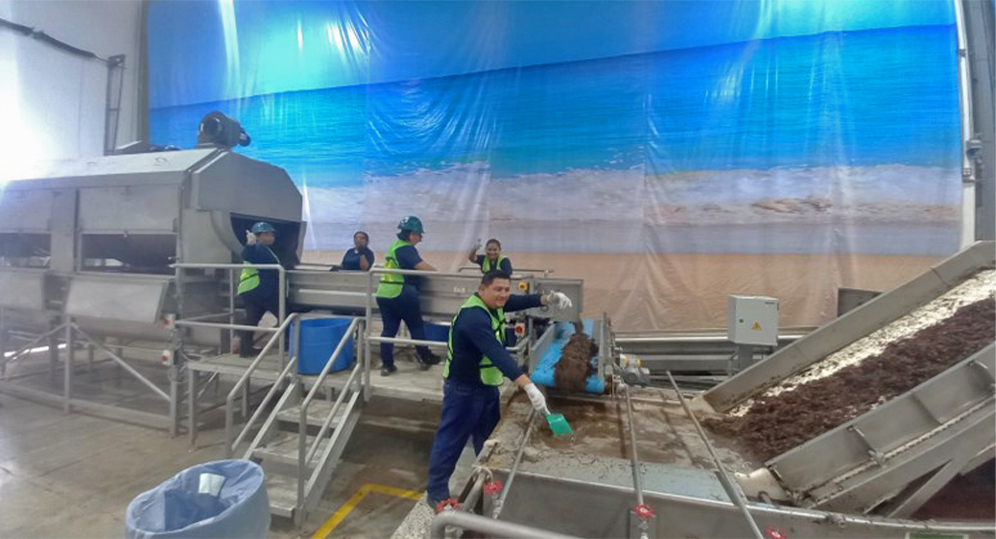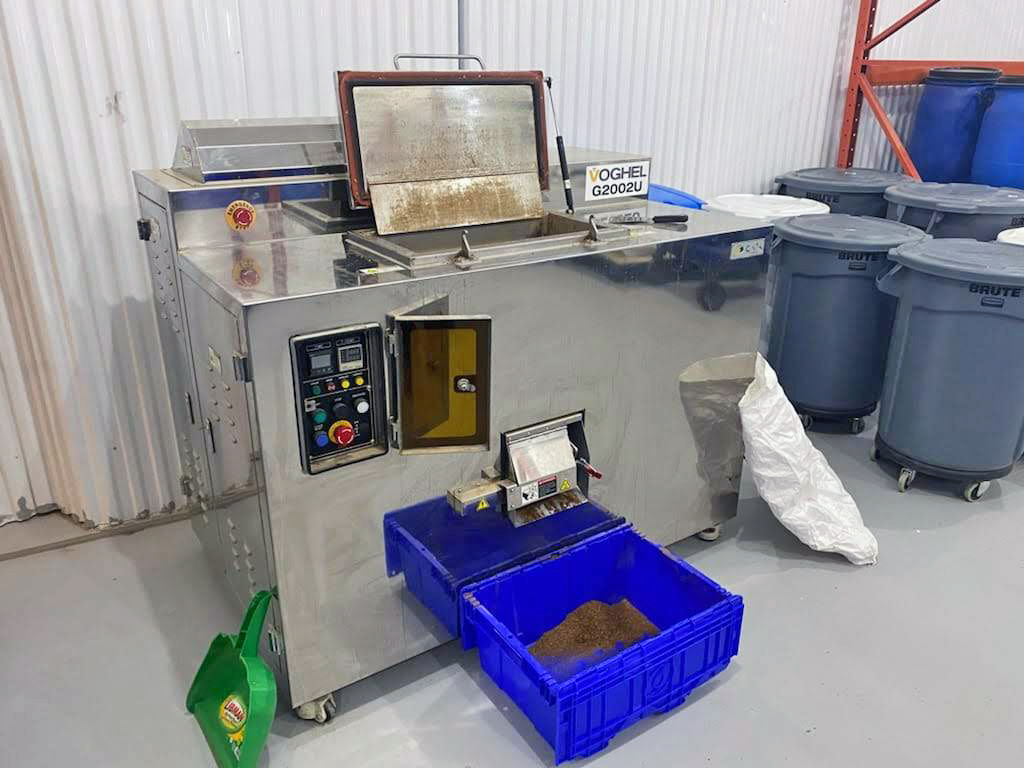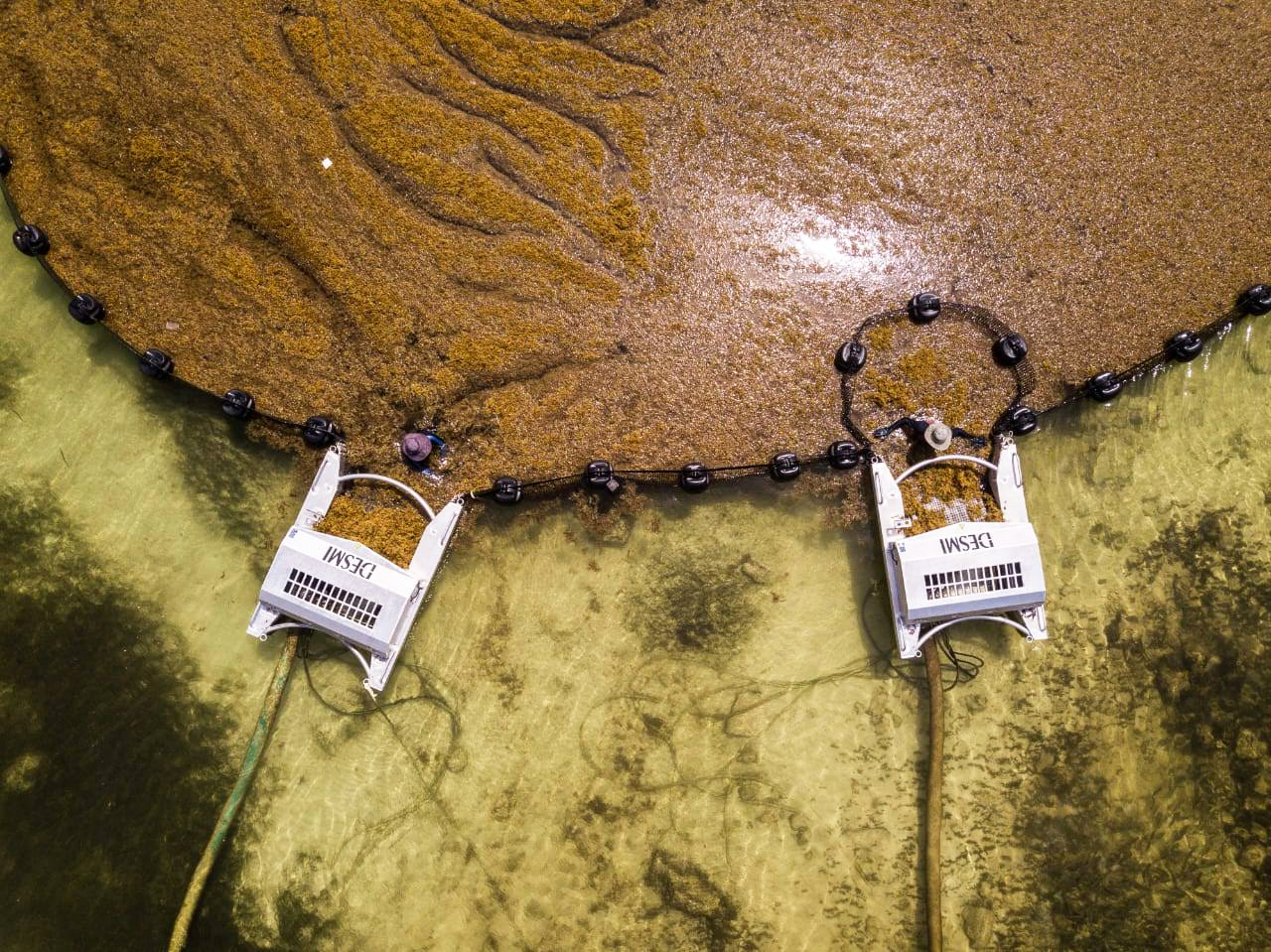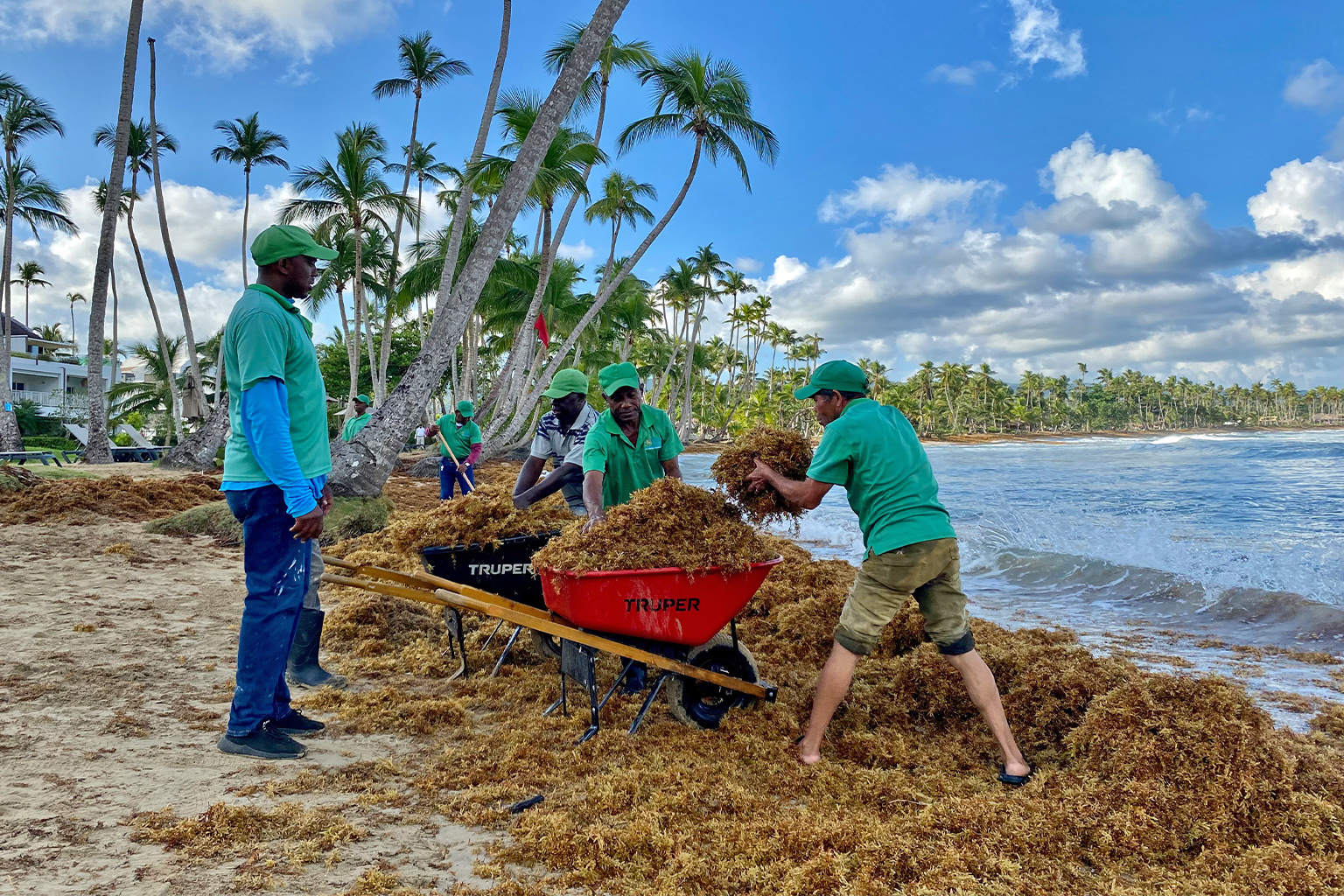- Since 2011, sargassum has worsened as a nuisance — possibly due to an influx of synthetic fertilizers into the Atlantic Ocean — with the brown algae washing up on Caribbean beaches where it rots, stinks like rotten eggs and devastates tourism, including in Mexico where 30 million go for beach holidays annually.
- Sea currents have made the beaches of the Mexican state of Quintana Roo a leading arrival point for the annual surge. So early on, scientists, members of civil society, politicians and businesspeople worked together to find solutions and turn the huge waste problem into an opportunity for new green businesses.
- Once cleaned of heavy metals, microplastics, sand and other detritus, sargassum is finding many uses, particularly as biogas, but also biofertilizer, cellulose packaging and even artificial vegan leather. But a national law regulating sargassum remains elusive, with the issue tangled up in Mexican bureaucracy.
- Debate is ongoing as to who should pay for disposal, for expensive recollection and transport of the algae. As entrepreneurs experiment, Mexico has become a regional leader in creating a sargassum industry, with other Caribbean nations seeking to learn from Mexico’s business mistakes and copying its successes.
2023 is shaping up to be a banner year for sargassum, a type of brown macroalgae now starting to wash up on beaches across the Caribbean. The thick dead tangled heaps of seaweed stink like rotten eggs and could cost many millions in holiday revenues this summer.
Explosive growth and overabundance of sargassum in recent years is possibly due to overuse by Brazilian industrial agribusiness of nutrient-rich synthetic fertilizers, which run off into tributaries feeding the Amazon River and the warming Atlantic Ocean. Fertilization by sewage flowing into the sea could also contribute.
But some entrepreneurs see this annual pest as a bonanza.

An oceangoing nuisance whose time has come
Sargassum isn’t new to the shores of Quintana Roo state in southeast Mexico. Researcher Rosa Elisa Rodríguez Martínez at the Institute of Marine Science and Limnology of the National Autonomous University lives in the coastal city of Puerto Morelos and she recalls the brown weeds washing ashore for decades. “But always in quite small quantities and during a short season.”
But from 2011 onward, quantities grew exponentially and the algae season extended longer. 2023 is on track to set a record for the disruptive vegetative plague. This spring, scientists at the University of South Florida College of Marine Science spotted a big yellowish-brown seaweed belt drifting from the Atlantic Ocean toward the Gulf of Mexico; they estimated its weight at 13 million tons, a record density for March.
Peak sargassum season doesn’t come until June and July, but tangles of the buoyant leafy plant have already begun washing ashore in the Caribbean and South Florida.
For Mexico, this year’s sargassum surge poses an especially urgent and vexing economic crisis. That’s because ocean currents make the 1,176-kilometer (730-mile) shore of Quintana Roo a prime landing spot. The state also boasts perhaps the most famous and visited Caribbean beach destination: Cancun. In 2022, more than 30 million visitors arrived at its airport; the majority headed to nearby beaches between the island of Holbox to the north and Mahahual, a diving hotspot to the south.
Sargassum is on track to turn the region’s inviting turquoise waters into an uninviting muddy green. Add to that the huge quantity of microplastics, heavy metals and other waste that piggybacks on the algae as it washes ashore, decomposes and emanates leachates and foul-smelling hydrogen sulfide gas dangerous for public health.
It’s also a problem for marine and coastal ecosystems, which are affected by lower oxygen concentrations, with sea turtles forced to struggle through the dense algae to dig their nests. The noxious weed is also expensive to collect and difficult to dispose of, becoming a financial burden and logistical challenge for authorities. Rodríguez Martínez calculates the cost of cleaning just 1 km (0.6 mi) of Mexican beach at up to $100.000.


Entrepreneurs to the rescue: Biogas leads the way
As the annual waves of algae worsened from 2011 onward, Quintana Roo and municipal officials, politicians, businesspeople, citizens, researchers and the Marina de México.came together early to find solutions.
Since then, a green sargassum industry has grown up. It started with innovative beach cleansing devices and today includes a range of industrial facilities dedicated to processing the algae into biogas, biofertilizers, bricks, packaging and even products for the cosmetic industry.
“Sargassum has interesting characteristics such as antibacterial, antihypertensive, anti-inflammatory and anticarcinogenic properties,” Rodríguez Martínez notes.
One sargassum business pioneer is Miguel Aké, a 73-year-old electrical engineer from Central Mexico. His company, NopaliMex, had been building and operating biogas plants fed by nopal cactus and avocado production waste for years. Then in 2019, he collected 45 tons of sargassum as an experiment and transported the algae to his facility in Zitácuaro in Michoacán state for tests.

The results were promising, he recalls, though there were challenges to resolve. The first was the necessity to clean the algae thoroughly of salt, sand, microplastics and heavy metals including lead, mercury and arsenic. That’s a problem that Aké says his company solved with high-pressure water spray and a patented physical process.
“We managed to produce biogas with a good methane content, on average 58-64%. Nopal is slightly better with 64-72% of methane,” he notes. But sargassum could potentially be used to run hotel hot water boilers on Quintana Roo’s coast, where LP gas is currently used. It could also be transformed into biofuel for vehicles or to generate electricity, but not without further processing, which would remove sulphuric acid, which can damage electrical generators and motors.
For now, hotel owners say they’re interested in using it in their boilers, and Akés’ business partners have already acquired land near the cities of Cancun and Tulum to build two plants, worth around 60 million pesos ($3.4 million) each. He is hoping to start construction in May. Because the raw material is free, the production cost for 1 liter (0.26 gallons) of sargassum biogas will be around two pesos ($0.1), he calculates, as compared with 1 liter of LP gas costing 13 pesos ($0.74).

Who will pay to transport sargassum?
Those numbers look very lucrative to investors, and Aké calculates that the conversion from LP to biogas could pay back in as little as two years. But that’s only if municipal authorities fulfil their part of the agreement and deliver the needed 300 tons of sargassum to the biogas plant daily for free.
That could be a problem, with authorities not eager to shoulder all the financial burden of transport — paying for moving the heaps of algae with taxpayer money while facilitating private profits.
At least, that’s what Hector Romero Morales with a company called Dianco experienced. He installed a plant a year ago near Puerto Morelos to make biofertilizers using sargassum as feedstock. But even though sargassum will likely be hitting the beaches in huge quantities this summer, that doesn’t mean it will easily reach his facility, which could process 600 tons daily, he says.
“The municipalities of Tulum and Playa del Carmen find it expensive to pay for diesel to transport the sargassum to our plant,” he reports. “We have proposed to divide the cost, but they didn’t agree.”


Romero Morales says he feels he’s doing the authorities a favor: Without his plant as a disposal destination, sargassum must be brought to landfills equipped with special geomembranes to avoid leakage that can contaminate groundwater.
The freshwater supply on the entire Yucatán Peninsula depends on limestone bedrock honeycombed with water-filled caves and underground rivers — surfacing in the famous cenotes popular with tourists. Polluting those natural pools and the aquifer would be a disaster. But local politicians so far haven’t been inclined to fund proper waste treatment, and specialized landfills to handle sargassum are expensive to build.
Private companies in charge of waste management in Quintana Roo usually don’t even accept sargassum — which has led municipalities to dump the algae wherever they can find a place: in the rainforest or on the sides of lesser travelled roads in the peninsula’s interior.
Biologist Rodríguez Martínez is highly concerned about the groundwater contamination issue and the dangers posed for ecosystem and human health due to careless disposal. It’s been “years since the first massive sargassum arrival, [but] we still don’t have one single authorized landfill,” the researcher says.

Regulatory roadblocks
Mexico’s young sargassum businesses, like any other new commercial venture, have had major hurdles to overcome. Bureaucratic barriers were the worst problem for the startups, and continue to be so, Rodríguez Martínez says. Since 2015, she has regularly participated in roundtables, spending hours and days listening to long debates as to whether sargassum should be defined as a resource or as waste — which completely changes the rules for treatment as well as the authorities charged with dealing with it.
Hotels and processing companies, for example, prefer that the sargassum be collected while still in the sea, out of sight of tourists and without hard-to-remove sand sticking to it. Several Mexican companies have even developed special methods of harvesting sargassum in the water, using barriers, barges, vacuums and conveyer belts.
But cleaning offshore or on remains a bureaucratic nightmare: “The [Marina de México] officially is in charge of sargassum in the sea. Then, at 50 miles from the beach, it is the responsibility of Zofemat [the Zona Federal Maritimo Terrestre], and on the beach, it is the responsibility of the hotel or municipality,” Romero Morales observes. “Originally, our idea was to collect [the algae] at sea, but there is so much corruption going on that we opted to receive sargassum from everyone willing to bring it to our factory.”
Battles over jurisdiction, environmental rules and disposal funding are being exacerbated by rival political actors. Their intractable differences have delayed a national legal framework addressing sargassum.
To avoid this regulatory snafu, Felix Navarete, president of the Ensol Caribe Group, adopted an innovative strategy. Ensol is part of an international venture capital group called Carbonwave; it has invested $4 million in an integral management business plan, collecting sargassum both off- and onshore and taking the waste in its own trucks to its facility, where the waste is transformed into biofertilizer and several other marketable products.

One product under development is a biostimulant for agriculture that allows plants to better handle heat stress or excess water — potentially valuable as climate change worsens. They also produce an emulsifier for the cosmetic industry and developed a prototype for vegan leather.
But getting past all the bureaucratic barricades isn’t the end of difficulties. Market realities also must be faced: Group Ensol’s biofertilizer, for example, has to find a niche in a highly competitive market where much cheaper alternatives such as phosphoric rock powder, liquid biofertilizers made from cow manure and charcoal soil amendments are more easily available.
Ensol Caribe is eager to enter the carbon credit market to capture green financing. “We aim to create a circular economy, e.g., delivering to the hotel who handed us over its sargassum, the finished products [to sell to tourists] made of vegan leather such as cup holders,” Navarrete explains.
Ensol is also experimenting with 3D printing using sargassum-based products — something Romero Morales has tried but isn’t convinced about: “We created and patented a cellulose packaging container made of sargassum,” he notes. “Kimberly-Clark [Corporation] was interested. But we left this for later, because only 10% of the sargassum can be converted into cellulose, and there is a lot of waste.”


The sargassum business road ahead
The entrepreneurs interviewed for this story agree that the intermittency of the sargassum beach season is one problem they can handle. Romero Morales, for example, has installed a huge collection center that allows the algae to be dried and cleaned for the winter season when beach arrivals stop. Flexible Mexican labor laws have been helpful in this regard: They allow companies to easily adjust their workforce according to production necessities.
Aké notes that his biogas plant can shift from sargassum to other biomass for feedstock, including organic waste coming from hotels. But he doubts this will even be necessary: “Seasons are changing. This year, sargassum started to arrive as early as January,” he points out.
Entrepreneurs are far more concerned about the persistent bureaucratic hurdles, especially those enforced by an entity called Cofepris, the Federal Commission for Protection against Sanitary Risks, a Mexican equivalent of the U.S. Food and Drug Administration. No product can be legally sold in Mexico without a label from Cofepris certifying that the merchandise represents no risk to human or animal health. But that Cofepris stamp of approval is yet to come to the products mentioned in this article.
According to Navarete, the primary challenge for the sargassum startup community is legal certainty. Mexico’s environment ministry is planning to finish a draft of sargassum regulations by the end of 2024, he says, but that has to pass through a legislative process that can last several years.

“It is illogical in an environmental crisis like this to delay permits and laws,” researcher Rodríguez Martínez admits. But she is also cautious and warns that much more research is needed to fully understand the impacts and dangers of processing and storing sargassum — as well as manufacturing it into a range of products.
So far, there is no national sargassum law or strategy, only recommendations by Mexico’s environment ministry. But despite the slow-moving regulatory process, progress has been made. And because the state’s beaches were among the first hard hit by the rising wave of brown macroalgae, Quintana Roo officials and entrepreneurs believe they’ve seen successes that could be copied by other Caribbean destinations.
“I received a call from [the Dominican Republic], but they want to see the results first,” Aké says. Mexico has a huge and growing sargassum problem, so it has become a major sargassum laboratory. If trends continue as this year, other countries are bound to see their coastal brown algae woes grow, too, with more entrepreneurs jumping in to find ways to turn nature’s annual pest into profits.
FEEDBACK: Use this form to send a message to the author of this post. If you want to post a public comment, you can do that at the bottom of the page.
Banner image: Cleaning a beach in the Dominican Republic. Image by Sandra Weiss.
Jatropha: The biofuel that bombed seeks a path to redemption
